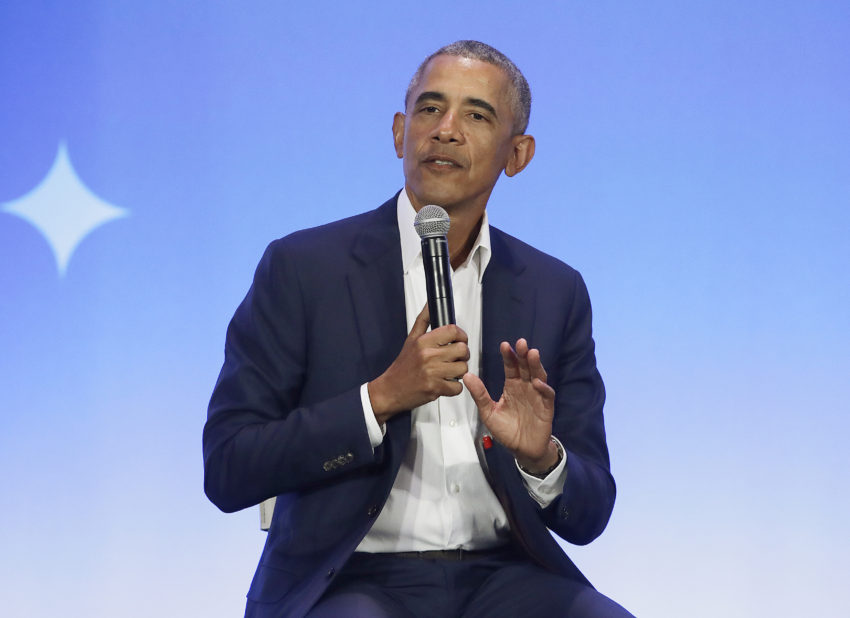Let’s Not Whitewash or Mythologize Obama
After two years of Donald Trump, many Democrats just want their president back. They underestimate the dangers of corporate liberalism. Former President Barack Obama speaks at the My Brother's Keeper Alliance Summit in Oakland, Calif. earlier this year. (Jeff Chiu / AP)
Former President Barack Obama speaks at the My Brother's Keeper Alliance Summit in Oakland, Calif. earlier this year. (Jeff Chiu / AP)
With former Vice President Joe Biden seemingly ready to join the presidential race, a Washington Post reporter recently wrote: “Biden and his allies picture an election that poses a choice between four more years of Trump disruption and a chance to restore the Obama administration.”
Ah, the hope of an Obama restoration!
But is a “return to normalcy” truly enough? After decades in which giant corporations have amassed huge political and financial control while racial and economic inequities kept widening—and with climate scientists now telling us that planetary survival requires radical reforms?
And what about the real danger that a return to Obama-style, go-slow “corporate liberalism” would lead to the next right-wing faux-populist upsurge, this time commanded by someone far smarter and slicker than Trump?
Given what Trump has done to our country and world, it’s no wonder that many Americans long for Obama. He was not a bigot or insult artist. His administration was not rocked by major scandal, with top aides off to prison. He was level-headed:“No Drama Obama.” He didn’t deny science. President Obama was smart, with a vocabulary clearly exceeding that of a 4th-grade child. He was hip.
That’s what millions of people remember.
I, too, remember all that. But we should also recall the political substance beyond the pleasant image.
We need to remember the vacillation—and worse, the opportunism and corporatism. As well as cause and effect: that Obama’s tenure paved the way for the rise of Trump.
Progressive analyst Matt Stoller made that case in a well-documented Washington Post column on the eve of Trump’s inauguration, headlined “Democrats can’t win until they recognize how bad Obama’s financial policies were: He had opportunities to help the working class, and he passed them up.” Stoller wrote of the Obama administration enabling nine million home foreclosures and anti-consumer corporate mergers, including dangerous consolidation in health care, partly caused by Obamacare’s “lack of a public option for health coverage.” Noting that most new jobs in the Obama years were temporary or part-time, along with the decline in lifespans among whites, Stoller concluded: “When Democratic leaders don’t protect the people, the people get poorer, they get angry . . .”
Back in 2008, I was delighted when Obama defeated the Clinton machine, seemingly for good. (If only!) But I wasn’t taken in by his “hope” and “change” rhetoric.
Obama’s first presidential run offered reasons to be skeptical—for example, how he broke records in pocketing Wall Street donations. Once in office, those ties hamstrung his economic policies.
I remember the opportunism of that campaign: How Obama and his team sought the endorsements of antiwar celebrities in 2007/2008 by saying, “All of our advisers opposed the Iraq invasion and all of Hillary’s supported it. Why are you on the fence?” And I remember that, as soon as Hillary was out of the race, Obama chose one pro-war associate after another, including running mate Joe Biden, probably the single most important Democrat in enabling the Iraq invasion.
Those hawkish appointees ultimately included Hillary Clinton at the State Department; they steered Obama to continue—and in some actions, areas and powers, expand—the ineffective and immoral “War on Terror” inherited from Bush, and passed on to Trump.
Two days after Obama’s 2008 election, I remember how even my small sliver of hope evaporated when he selected Rahm Emanuel as his chief of staff—a stridently pro-corporate, pro-war Democrat despised by progressives since he worked in the Clinton White House and helped lead legislative campaigns that pushed through the NAFTA trade pact, the 1994 crime bill, and welfare “reform.”
Like Emanuel, Obama’s next two chiefs of staff also came out of big finance: William Daley from JPMorgan Chase and Jacob Lew from Citigroup.
It’s well-documented that Obama loaded his team of economic advisers with Wall Streeters. So it’s no accident that Wall Street was bailed out rather than underwater homeowners during the biggest foreclosure wave in US history. The inside story of Obama’s semi-regular capitulation to economic elites is told in Ron Suskind’s book “Confidence Men: Wall Street, Washington, and the Education of a President.” Largely with GOP support—and over the objections of most Democrats in Congress—Obama kept pushing the corporate-friendly Trans-Pacific Partnership trade deal until his last months in office.
Obama appointed Monsanto executives and allies to key food and agriculture jobs. While he acknowledged the science of climate change and talked of the need for action, Obama’s tenure coincided with a boom in U.S. oil production and lethal infrastructure, and his administration fervently promoted fracking worldwide.
His health care reform, which originated with the conservative Heritage Foundation, expanded health coverage largely by enriching private insurance firms and Big Pharma, whose lobbyists were allowed to obstruct cost controls. Obamacare did expand Medicaid and increase coverage in poor and rural communities and to young people, but it still left millions uninsured.
In one lengthy, link-filled sentence, journalist Nathan J. Robinson summarized the progressive critique of Obama:
He deported staggering numbers of immigrants, let Wall Street criminals off the hook, failed to take on (and now proudly boasts of support for) the fossil fuel industry, sold over $100 billion in arms to the brutal Saudi government, killed American citizens with drones (and then made sickening jokes about it), killed lots more non-American citizens with drones (including Yemenis going to a wedding) and then misled the public about it, promised ‘the most transparent administration ever’ and then was ‘worse than Nixon’ in his paranoia about leakers, pushed a market-friendly health care plan based on conservative premises instead of aiming for single-payer, and showered Israel with both public support and military aid even as it systematically violated the human rights of Palestinians.
Yes, Obama faced intense Republican obstruction in Congress. But it wasn’t Mitch McConnell who stacked the Obama administration with corporatist appointees and policies.
In pure math, Obama’s tenure was a boon to the GOP—Democrats lost their big majorities in the U.S. House and Senate and nearly 1,000 state legislative seats, while the 50 governorships shifted from a sizable Democratic margin to strong Republican majority.
My point is simple: It’s not good enough to “restore” Obama-ism. Look at the recent pattern of presidential history: When corporate-beholden Democrats win the White House and implement cautious, status-quo policies while inequality worsens, two things happen: 1) Right-wing Republicans quickly take back Congress, and 2) An even more dangerous GOP president follows.
The last two Democratic presidents gave “hope” a bad name. First, Bill Clinton, “the man from Hope (Arkansas),” and then Barack Obama, whose iconic campaign poster featured the word. Both made it difficult for their successor to be a Democrat.
To break this hopeless cycle, what’s needed is the election of a progressive president who will fight to radically shift power and wealth away from the corporate 1 percent toward a multi-racial coalition of the 99 percent and toward environmental sanity. Bernie Sanders would fit the bill. So might Elizabeth Warren. But tepid Democrats who preach moderation and bipartisanship—and seek to restore Obama-era incrementalism—never will.
The outcome in 2020, as in the last presidential election, may well hinge on Midwestern voters and two essential questions: 1) Will youths and people of color be inspired enough to turn out in big numbers for the Democratic candidate? 2) Will working-class whites swing back to the Democrats?
I learned a bit about white, working-class voters in the “Rust Belt” while co-producing a new documentary movie, “The Corporate Coup D’Etat,” on the simultaneous, 40-year rise in both economic inequality and corporate political power. Our film team interviewed corporate-loathing Ohioans who’d voted for Obama, chose Bernie over Hillary in the Democratic primary, and then flipped to populist-sounding Trump in the general election as an alternative to the dreaded status quo.
Winning back these voters—and inspiring voters of color and youth—will require a Democratic nominee who is a forward-looking, progressive populist.
While it’s true that “any Democrat is better than Trump,” reverting back to the Obama era is a return to a status quo that stopped working for millions of voters long ago.
Your support is crucial…With an uncertain future and a new administration casting doubt on press freedoms, the danger is clear: The truth is at risk.
Now is the time to give. Your tax-deductible support allows us to dig deeper, delivering fearless investigative reporting and analysis that exposes what’s really happening — without compromise.
Stand with our courageous journalists. Donate today to protect a free press, uphold democracy and unearth untold stories.







You need to be a supporter to comment.
There are currently no responses to this article.
Be the first to respond.